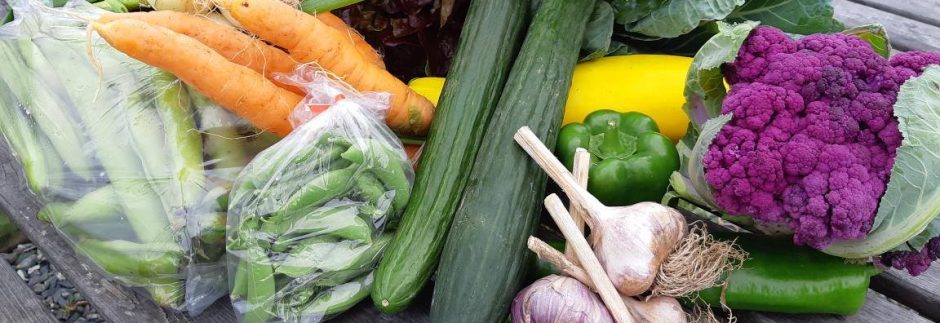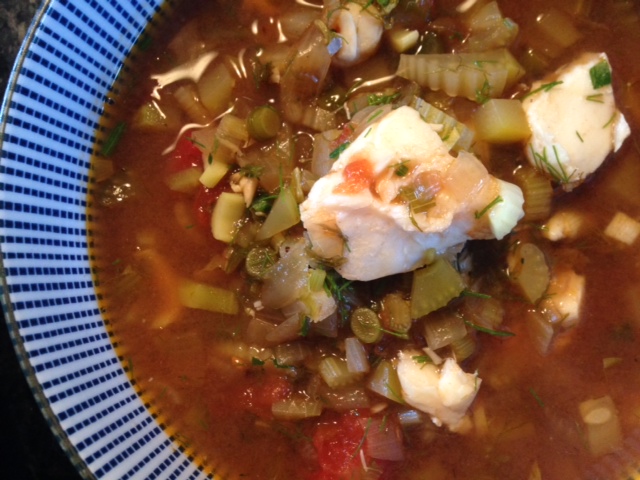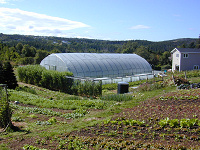Catherine Mah
A lot of the magic in delicious vegetable cookery comes from layering of flavours and textures.
Just as plain cakes can be made memorable by changing the layers of fruits, icings, fillings, and other accompaniments, so too can many vegetable-only dishes benefit from thinking in layers when cooking or serving to liven up the dish.
The best example of where a layered approach works well is soup. Many recipes for soups, especially vegetable-only soup, call for vegetable stock. Stocks are useful, but they are not the only answer for tasty soups, especially when putting together a simpler weekday meal or when trying to decide how to use specific vegetables in the CSA bag that week. When planning a soup, I like to think about making soup in layers in the pot. Here is how I build up a vegetable soup in layers from scratch without stock. This will be a great weekend for soup as we fortify ourselves for the hurricane!
The first layer is the foundation. This usually involves browning onions, as I described last time. One the onions are browned, then a few foundational vegetables can be added and cooked with the onions to create a stock-like base for your soup. This sauteed vegetable
base—often a combination of onions, carrots, and celery—is called a mirepoix in French cooking or a soffritto in Italian cooking. Be selective—one or two vegetables beyond the onions are usually plenty. But this is also a moment to be creative too and think about the finished soup will taste. Fennel, leeks, carrots, peppers, fresh ginger, and celery are all good options. Fennel adds mellow sweetness and a distinctive herbal taste. Shallots and leeks add some complexity. Carrots, chile or bell peppers are sweet and
bold. Be careful with too many carrots or peppers as they can easily dominate a soup—unless you are making carrot soup! I like carrots best in a winter squash soup, or tomato-based vegetable soup. Fresh ginger adds spice, aroma, and heat. My all-time favourite is celery. Celery is the secret to great fish soup, minestrone, leek soup, and many others!
The second layer is for strong aromatics: robust fresh herbs like sage or rosemary, dry spices, and fresh garlic. Frying bold herbs and dry spices briefly at this point, before adding water, brings out their flavour and makes the base of the soup more intense and
interesting. Garlic can easily be burned if added too early, so this is the best time to include it.
The third layer is the main body of the soup. Add boiling water—never cold—and scrape the bottom of the pan to release any browned flavourful bits. Bring to a vigorous boil, add salt and pepper to taste, then add the main ingredient vegetables and grains (see some of the formulas below) and reduce to a simmer.
The fourth layer finishes the cooking by balancing the soup—these can also be thought of as the ‘tart-fresh’ elements. Once the main ingredient vegetables are tender and the broth has good flavour, turn off the heat. The fresh element comes from chopped fresh, delicate herbs like parsley, cilantro, tarragon, or chives, which will wilt in the residual heat but retain their green colour and aroma. The best tart element is lemon juice. A bit of lemon juice to finish a soup (often just a teaspoon) adds a brightness and savouriness and
reduces the amount of salt needed for final seasoning. Good alternatives are red wine vinegar or balsamic vinegar for tomato-based soups, or cider vinegar for squash, beet, or carrot soup.
The fifth layer is for texture when serving. Sometimes I top soups with snap beans or hearty greens, chopped fine and fried vigorously with garlic and olive oil. Good options for crunch are garlic croutons, roasted nuts and seeds, a fresh salsa of tomatillo with white
onion, or one of the vegetables from the earlier layers chopped very fine and added to the soup raw. Alternatively, shavings of firm cheese, or a dollop of yoghurt, creme fraiche, or sour cream will add creaminess and cool down the soup.
*A few formulas for layered soups
*(Suitable for a 3 quart saucepot, enough for a hearty main dish soup for two and lunch the next day.)
FAVOURITE FISH SOUP
Layer 1: 1 large yellow onion cubed, 2 stalks celery chopped, 1 bulb
fennel chopped
Layer 2: 1 tsp whole fennel seeds, 1 tsp whole coriander seeds, 1 tsp
Mt. Scio savoury, 1/2 tsp ground black pepper, 2 cloves garlic minced
Layer 3: 6 cups boiling water, 14 oz can diced tomatoes, minced stems of
1 small bunch parsley, 1 medium waxy potato diced small—let the
tomatoes, parsley stems, and potato cook for about 10 minutes before
adding fish; then add 3 filets of cod with 8 large scallops and
simmer them gently for 6 minutes until just able to flake the cod.
Layer 4: minced leaves of 1 small bunch parsley, lemon juice to taste
Layer 5: 1 minced celery heart stalk added raw (the pale yellow inner
stalks, with leaves) and garlic croutons: toast cubes of hearty bread
like sourdough and while still hot, immediately toss in a bowl with a
swig of good olive oil, 1 clove garlic minced very fine, some
minced parsley, salt and pepper
AUTUMN MINESTRONE
Layer 1: 1 large red onion cubed, 2 stalks celery chopped, 1 large
carrot sliced into thin rounds
Layer 2: 4-6 cloves garlic sliced, 1 tsp ground black pepper, 1 sprig
rosemary minced finely
Layer 3: 6 cups boiling water, 14 oz can diced tomatoes, minced stems of
1 medium bunch parsley, 1 cup cubed winter squash (buttercup, butternut,
or delicata are best), 1 can white beans drained and rinsed well, 1
tablespoon of your favourite small pasta (I like mini alphabets)
Layer 4: minced leaves of 1 small bunch parsley, lemon juice to taste
Layer 5: shaved firm cheese such as parmigiano reggiano, pecorino, or
aged Gouda
SPICY SQUASH SOUP
Layer 1: 1 large yellow onion cubed, 1 shallot minced, 1 stalk celery
chopped, 1 small carrot chopped
Layer 2: 1 inch knob of fresh ginger sliced finely, ½ tsp powdered
ginger, pinch cayenne
Layer 3: 8 cups boiling water, 3 cups cubed winter squash, 1 small red
chile or bell pepper seeded and chopped, 1 small potato cubed
Layer 4: when the soup is ready, puree with a stick blender and then add
lemon juice to taste
Layer 5: dollop of yoghurt, roasted pumpkin and sunflower seeds tossed
in olive oil
CREAMY TURNIP AND LEEK SOUP
Layer 1: 1 large yellow onion, 1 stalk celery chopped
Layer 2: 1 tbsp dried or fresh sage, 1 small sprig rosemary minced
finely, 1/2 tsp ground black pepper
Layer 3: 8 cups boiling water, 2 large leeks cleaned and chopped, 1
medium rutabaga cubed, 1 small white turnip or 3 small radishes cubed, 1
tbsp long grain rice
Layer 4: when soup is ready, puree with a stick blender and then add
just a drop of lemon juice
Layer 5: small Brussels sprouts halved and fried with garlic and bacon



 A special message from Mike Rabinowitz: Celebrating the Life of Melba
A special message from Mike Rabinowitz: Celebrating the Life of Melba